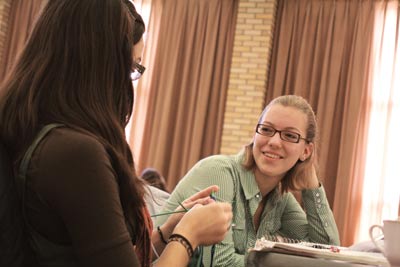Canadian Mennonite
Volume 13, No. 23
Nov. 30, 2009
Coming at peace from different directions
Winnipeg
 |
What happens when just war theologians and church leaders meet face to face with their pacifist counterparts to talk about war and peace?
Last month, 43 members of Mennonite Church Canada and the Christian Reformed Church of Canada (CRC) took part in the Symposium on War and Peace at Bethel Mennonite Church, Winnipeg.
The Reformed Church has a long-standing tradition of just war theology—war should be used only as a last resort for the defence of the weak and vulnerable who are unable to defend themselves—and obligatory military service to one’s country, because “government is a positive force in our society and divinely ordained,” said Bruce Adema, director of Canadian ministries for the binational CRC, although he acknowledged that duty to obey the government is neither absolute nor unconditional, but subject to God’s law.
Adema said that Reformed adherents live in a tension: In one hand they hold a deep desire to “never want war,” and in the other hand they hold a desire to stand up for the weak and vulnerable, using redemptive violent military force if no other solution is evident. However, “if just war happens, we have not been effective agents of peace,” he admitted.
Much passionate conversation ensued when Reformed and Mennonite participants were paired up and assigned the task of creating a Remembrance Day service palatable to both denominations. A common theme that emerged was that such a service would need to focus on lament for all war dead, rather than honouring only those who gave up their lives in military service.
Position papers from each denomination were also presented.
Herman Keizer, a theologically trained, retired military chaplain from Grand Rapids, Mich., and a long-time high-level ethical advisor at the Pentagon, said, “As we walk through some of our history on war and peace, we have gained a deeper appreciation of the Peace Churches and what they can contribute to our efforts to be peacemakers,” citing a recommendation from a 2006 synod calling for the CRC to work more closely with Peace Churches and learn from one another.
With a Purple Heart pinned to his lapel, Keizer advocated for a re-examination of attitudes about conventional weapons. “In World War II, only 20 percent of the fighting force shot to kill,” he said. “Today, that is up to 85 percent. . . . We, the U.S. and Canada, have trained—and have fielded—the deadliest and most lethal force in the history of war fighting. I am concerned because soldiers are more concerned with killing than being killed.”
Helmut Harder, emeritus professor of theology at Canadian Mennonite University, Winnipeg, and former general secretary of the Conference of Mennonites in Canada (the precursor to MC Canada), addressed the question of how Mennonites have responded to contemporary chal-
lenges on issues of war and peace, and how this has shaped and reshaped its identity. Challenges to absolute pacifism by some of those in attendance were rewarded by Harder’s simple explanation that “extermination of life is always wrong.”
CRC members would not disagree with Harder’s assertions that “we believe that peace is the will of God,” and it is most fully revealed in Jesus. However, exegetical differences showed fissures on how peace can be achieved. Jesus’ claim in Matthew 10:34—“I have not come to bring peace, but a sword”—were filtered through both CRC and Mennonite lenses. Mennonites interpret this story as the suffering servant model: Jesus sought to bring peace by making himself a sacrifice of the sword, instead of wielding it, while the CRC understands that the text does not forbid the use of violent force.
The event inspired better understanding between the two denominations—and perhaps a renewed valuing of those who have different understandings of peace and how to achieve it.
Jeremy Segsto, a CRC representative in Grade 12 at a Mennonite school, said, “Before today I saw very different and distinct views of Christianity, but they’re actually very similar and they’re exactly the same in the most important aspect of it, in that we all have the same goal in mind.”
Natasha Plenert, a Mennonite student at CMU, observed that among her peers it was very easy for her to write off people with non-pacifist viewpoints as being pro-war. “There’s a very big distinction to be made between not thinking war is wrong and thinking war is the right answer,” she said.
The symposium was the product of discussions between MC Canada general secretary Robert J. Suderman and Adema, following a May 2008 Canadian Council of Churches’ event in which Suderman presented a paper entitled “Faith and the public square: The church’s witness to peace.”